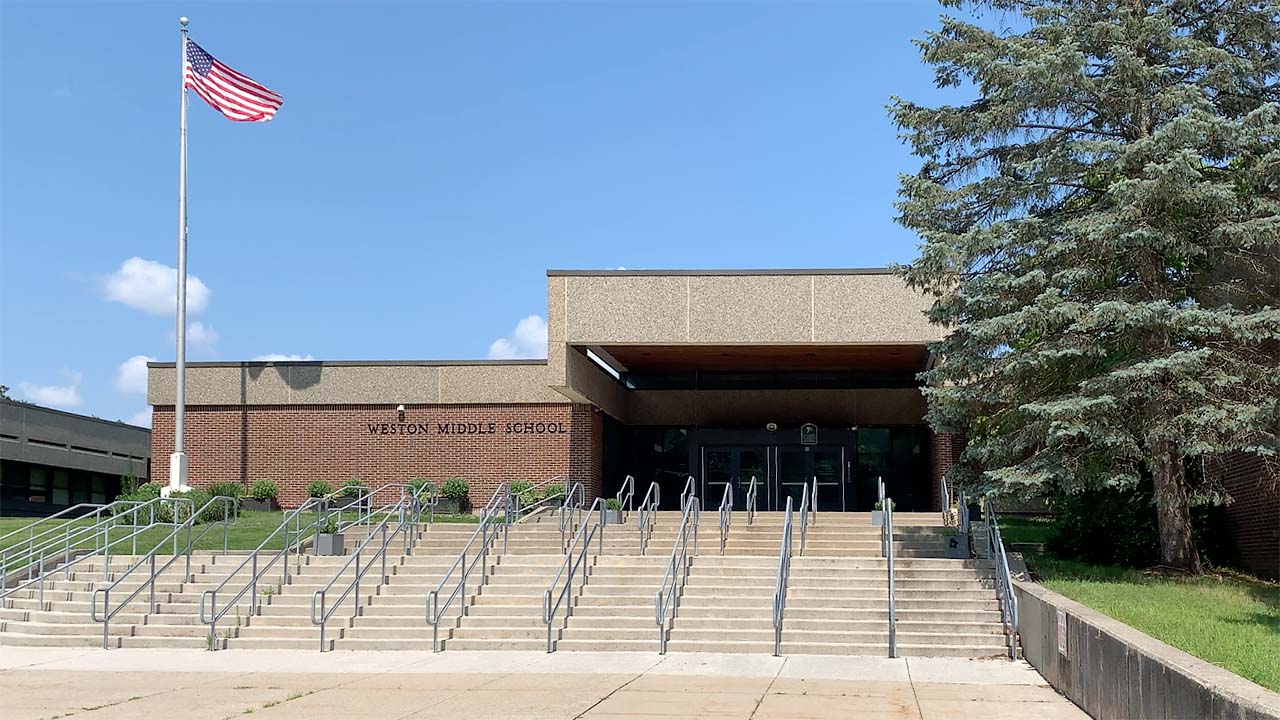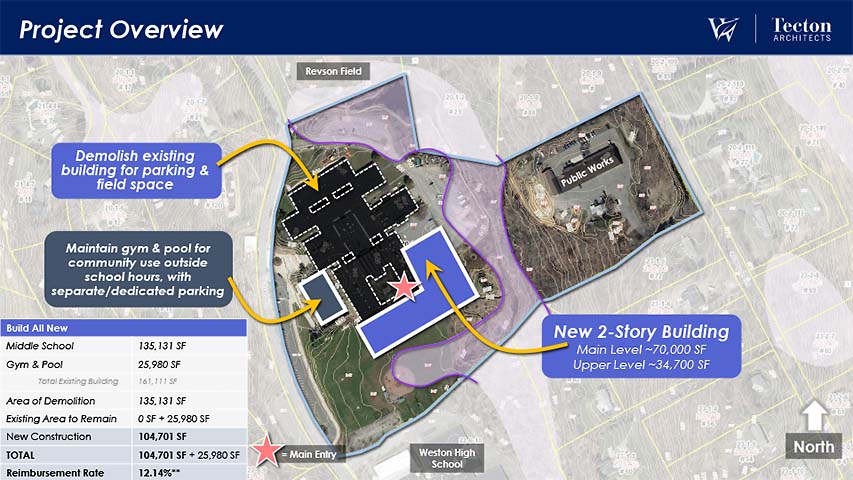On the Table: Brand New Middle School

Weston Today photo
Construction of a new Weston Middle School building — and demolition of the existing one — is now on the table as a proposed solution to the school’s deteriorated condition.
The estimated cost to Weston taxpayers comes in at around $88 million.
The Board of Education meets on Monday, May 20 at 7:00 pm, in person and livestreamed, to discuss in more depth concepts presented in a special meeting on May 15 and may decide next steps.
The actual cost of construction for the school envisioned, all in, is estimated at just under $112 million. But if the project proceeds, a state grant could reimburse as much as 22.14 percent of costs, the town’s maximum eligibility at current rates. There is an asterisk on that, coming up later in this report.
Everyone involved seems aware of the eye-popping nature of these numbers.
In the meeting on the 15th, school board members heard from Jeffrey Wyszynski and Antonia Ciaverella of Tecton Architects, who have worked with Weston for the past several years on facilities planning and have developed a conceptual design. Members also heard from Superintendent Lisa Barbiero and Peter Gordon, the board’s Education Optimization Committee (EOC) chair. A few town residents spoke in the short time allowed for public comment.
What may come next
The opportunity to apply for a school construction grant arrives only once a year. The Board of Education will have to decide whether to go for it this year. The deadline is June 30.
Nothing about that decision commits the town to bond, build a school, or do anything at all. It only gets the ball rolling, first to the Board of Selectmen, who must agree to move ahead.
The school board must also approve educational specifications for a new building. This is a requirement of the application process, and it is extensive. A draft produced by Tecton runs nearly 200 pages.
If the Board of Education votes to try for a grant this year, they must ask the Selectmen to authorize an application. The Selectmen would also have to appoint a separate and dedicated educational building committee, which would oversee the project.
A public vote
At some point, the Selectmen would also have to schedule a referendum. Applying by June 30 this year would require a referendum to be held and the vote certified by November 15.
The referendum question would be whether Weston voters approve funding construction of a new school. The stated amount would be the full $112 million (rounded here), but noting or making contingent the prospective state reimbursement resulting in a net $88 million local share.
If the referendum passes, later in the year word would come from the state’s Office of Grant Administration that Weston’s application either has or hasn’t made a priority list drawn up by the office.
That list is submitted to the General Assembly, which would vote on it early in 2025. Only then will applicants know if their grant is approved. If approved, the town has two years to start construction or surrender the grant.
Why a new school?
The poor condition of Weston Middle School has been known for years. A facility assessment conducted in 2017 estimated costs totaling over $17 million just to correct problems known at that time. Adjusted for inflation, we estimate that would be $22 million today, or possibly more in the neighborhood of $30 million, since inflation of construction costs is greater than that of the Consumer Price Index.
According to the latest assessment, the school’s current defects include exterior and interior decay, an aged-out fire alarm panel, no fire protection system, assorted plumbing issues, a lack of humidity controls, a gymnasium without air conditioning, old electronic controls, limited electrical distribution, outdated lighting, poor energy efficiency, and numerous ADA and building code shortcomings.
Tecton’s report also concludes that the school is larger than it needs to be, but at the same time only 40 percent of its space is usable for educational purposes.
The school was built in 1960. It was enlarged by major additions in 1970 and 1996, changes that affected flow and left a disjointed distribution of classrooms and grade levels.
“21st century spaces”

Tecton Architects slide
The conceptual design on the table is for a smaller middle school that is flexible, accommodates modern educational modes, enhances safety, is energy efficient, environmentally sensitive, and less costly to operate.
In addition to separating the existing gym and swimming pool from the building for use by the community when school is not in session, the concept envisions “21st century learning spaces,” a free-flowing design with breakout areas, curved hallways, usable courtyards, outdoor learning, gardens, views of the natural surroundings, meeting and conference areas, and accommodations for the arts.
The idea is to move away from the old school model of corridors with classrooms where students spend the day sitting in chairs at tightly aligned rows of desks.
The concept is described as creating a learning environment that fosters the physical and emotional health of students, builds the best space where they can thrive, and gives them a sense of belonging, working in small learning communities.
The grant
The smaller size of the school envisioned is significant, coming in at about 140,000 square feet total compared to the existing building’s 161,000. It is just under the cap of a state metric that affects reimbursement eligibility.
By the book, at current rates a new building in Weston would qualify for only 12.14 percent reimbursement. But at the size currently contemplated, and if it can be demonstrated that building new would be economically as good or better than an alternative to “renovate as new,” the higher 22.14 percent reimbursement could be awarded. That’s the asterisk mentioned earlier.
“Renovate as new” involves renovating about half of an existing structure and demolishing all or part of the rest to make room for new construction. Tecton’s analysis suggests that this approach would cost somewhat less initially but several million more by the time work is complete and the ribbon is cut.
In addition to being more disruptive to education, Tecton reports that renovating as new takes twice as long as building new. Work is done in stages over several years, making the disruption last longer and giving inflation more time to escalate costs.
